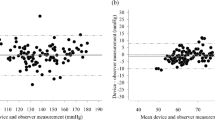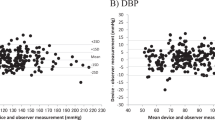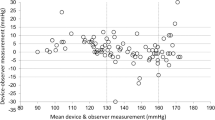Abstract
The reference level for the measurement of blood pressure (BP) is the level of the right atrium. In practice this is regularly disregarded, as the patient’s arm is usually placed lower than the right atrial level. The aim of the study was to determine the influence of first, different arm positions and second, different transducer positions on the intra-arterially (i.a.) recorded BP. In 16 healthy men (age 28.1 ± 8.0 (s.d.) years), i.a. BP was recorded at the left arm in supine position, using a 5–7 cm long cannula. The baseline position was with the tip of the cannula placed precisely at the level of the right atrium. Subsequently, the following changes were made: 5, 10, 15 and 20 cm above and 5, 10, 15, and 20 cm below the baseline position. A 2-min rest period was allowed in each position before the BP was measured. The whole procedure was done either with the transducer connected to the arm at the place of the cannula (n = 7), or with the transducer placed next to the subject and continuously kept at the right atrial level during the BP measurement (n = 9). Simultaneously, baseline BP was measured indirectly, with a standard mercury sphygmomanometer, in the opposite arm maintained with the cubital fossa at the right atrial level during the whole procedure. This resulted in the first group of seven volunteers for both the i.a. systolic (SBP) and diastolic BP (DBP) values to significantly decrease (P < 0.001) when the arm together with the transducer were elevated above the level of the right atrium, and returned to the initial value when the arm and the transducer were placed back at the right atrial level. intra-arterial sbp and dbp significantly (P < 0.001) increased as the arm, together with the transducer, were lowered below the right atrial level and returned to the initial value when the arm and the transducer were placed back at the right atrial level. in both directions, each 5 cm change in the arm level was accompanied by a 3–4 mm hg change in the i.a. bp value. the baseline bp, measured sphygmomanometrically at the contralateral arm, remained constant during the whole duration of the procedure. the changes in the i.a. bp were minimal in the second group of nine subjects in which only the arm but not the transducer was placed at different levels. we conclude that small deviations in arm position above or below the ‘gold standard’, ie, the fossa cubiti at the right atrial level, will result in largely erroneous bp values. the correct positioning of the arm during bp measurement is therefore mandatory for the diagnosis and follow-up of hypertensive subjects.
This is a preview of subscription content, access via your institution
Access options
Subscribe to this journal
Receive 12 digital issues and online access to articles
$119.00 per year
only $9.92 per issue
Buy this article
- Purchase on Springer Link
- Instant access to full article PDF
Prices may be subject to local taxes which are calculated during checkout
Similar content being viewed by others
Author information
Authors and Affiliations
Rights and permissions
About this article
Cite this article
Netea, R., Bijlstra, P., Lenders, J. et al. Influence of the arm position on intra-arterial blood pressure measurement. J Hum Hypertens 12, 157–160 (1998). https://doi.org/10.1038/sj.jhh.1000479
Received:
Accepted:
Published:
Issue Date:
DOI: https://doi.org/10.1038/sj.jhh.1000479
Keywords
This article is cited by
-
Work-related risk factors for ulnar nerve entrapment in the Northern Finland Birth Cohort of 1966
Scientific Reports (2021)
-
Differences in Blood Pressure by Body Position (Supine, Fowler's, and Sitting) in Hypertensive Subjects
American Journal of Hypertension (2011)
-
Both body and arm position significantly influence blood pressure measurement
Journal of Human Hypertension (2003)



